MANAGEMENT...
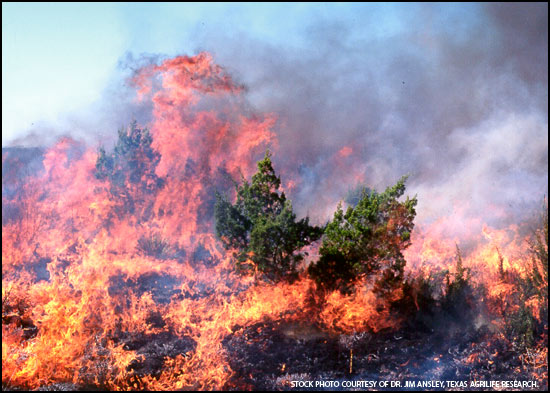
Prescribed Burning
a Tool for Brush Management
Ranch owners tell the good, the bad and the ugly.
The sprawling JA Ranch has seen its share of fires — some intentionally set and some not. Ranch managers now are looking at the results of the fires to help determine how prescribed fire could be used for brush management on their property. Read more.
Spread of Western Juniper Seeds Studied
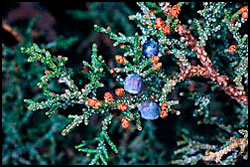
ARS ecologist William S. Longland is trying to determine what gives western juniper a competitive advantage in the environment. (PHOTO COURTESY OF JOSEPH M. DITOMASO, UNIVERSITY OF CALIFORNIA-DAVIS, BUGWOOD.ORG)
Aromatic, evergreen foliage and plump, dusty-blue to nearly purple berries make western juniper appealing, whether it's a small shrub or a lofty tree. The trouble is, during the past 100 years or so, some once-open western juniper woodlands in this species' native range of California, Oregon, Nevada, Idaho and Washington have become dense stands.
The result is that fire-danger ratings can skyrocket, according to Agricultural Research Service (ARS) ecologist William Longland at the agency's Exotic and Invasive Weeds Research Unit in Reno, Nev. What's more, the stands crowd out tasty, nutritious understory plants that cattle and wildlife could otherwise graze or browse. Read more.
Super-sized Cows Require Appropriate Management
It is a truth hiding in plain sight: Mature weight and milk production of many commercial beef cows are both greater than they were 30 years to 40 years ago, and that means management considerations must change as well.
Oklahoma State University (OSU) animal scientists Bob Kropp and Glenn Selk explain that many commercial ranchers underestimate the mature size of their cows simply because they have not weighed the adult cows to know what average mature weight to expect.
"Today's cows are not the type your grandfather was used to raising," said Selk, OSU Cooperative Extension livestock reproduction specialist. "To expect large, heavy-milking cows to be in moderate body condition at calving and maintain condition through breeding, they must receive more feed than smaller, lighter-milking cows." Read more.
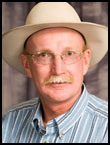
Ron Torell
Back to Basics
Make hay when the sun shines.
There wasn't a lot of sun shining in much of the Great Basin and Intermountain West during the month of June. Instead, unseasonably wet weather delivered as much as 4 inches (in.) of moisture to many hayfields during harvest. The result is thousands of tons of rain-damaged or late-maturity harvested beef hay on the market at reduced prices. In this issue of "Back to Basics" let's discuss rain-damaged hay. Read more.
Tips to Beat Old Man Winter
All-weather feed structures make winter chores a breeze
This is an example of the practical, production-oriented stories provided in the Angus Journal. To subscribe,
click here.When winter winds howl through the Smokey Mountains, Angus breeder David Freeman of Mars Hill, N.C., appreciates his versatile winter feed structure. These open-sided structures are built on concrete pads and combine hay feeding racks or silage feeders with freeze-proof water fountains and manure storage areas under the roof.
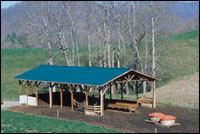
The racks in Freeman's structure are built on wheels and hold up to 10 days' supply of hay. During winter, Freeman scrapes the concrete pads with his tractor/loader and stores the manure until it's time in early spring to apply the nutrients to pastures as fertilizer.
By feeding hay in racks protected from weather damage, hay waste is reduced by up to 40% compared to feeding bales on the ground. The concrete pads provide firm footing and a healthy environment for cattle. Storing the manure during winter and applying the nutrients to pastures at the optimum time saves approximately $1,400 per year in fertilizer value and protects the water quality in nearby streams. Read more.
Tips for Warming Cold Calves
Calves that become chilled soon after birth must be warmed and dried immediately. The quickest way to warm a cold calf is with warm water or warm air. Calf warming boxes work well, especially if warm air comes up through the floor, drying and warming the underside of the calf as well as the rest of its body surface. Breathing warm air is also helpful.
"Warming the lungs helps warm the body core," says James England, University of Idaho Caine Center. "All the blood goes through the lungs. This is just as important as warming the extremities.
England says your first option might be to put a cold calf on the floor of your pickup with the heater running, if you find it far from the barn.
Hot water is the quickest way to warm/thaw a freezing calf. A warm bath works well, as long as water isn't too hot. If the water is too hot, it may damage frost-bitten skin or provide such a shock that the calf's heart stops. A warm, wet cloth can thaw frozen ears or tail if you don't want to get the whole calf wet.
The disadvantage to using water is it is labor-intensive. The calf must be thoroughly dried before you take it outdoors again.
"Get warm milk or colostrum into him as soon as possible, tubing it if he's too cold to suck," England advises. "This will give him energy to create body heat."
Yet Another Use for Duct Tape
To keep newborn calves from freezing to death during a cold spell, our son and his wife thaw and warm dozens of calves in the little trailer house they use as a "cow camp." Sometimes they have five or six new babies in there at once, warming and drying by the stove, feeding them colostrum via bottle or stomach tube before taking them back outside to their mothers. To make sure they never have a mixup regarding which calf is which, they use duct tape to tell them apart.
They don't put ear tags in during a cold spell, since some ears might have already been frozen, and the calves could lose ear tips and possibly their tags. Writing mama's number with a marking pen on duct tape and sticking it onto calf's back enables them to always take the right calf back to its own mother.
A bunch of newborn Angus calves can look similar to a sleep-deprived stockman during calving season, but duct tape ID makes it easy to tell them apart. The tape stays on extremely well. Some calves wear their temporary numbers a week or more after they're back in the field with their mamas.

Kris Ringwall
Beef Talk
Collaborative thought is better than competitive strategy.
Steer No. 2 was sold for $84.76 per hundredweight (cwt.) of live weight minus shrink (Oct. 23 six-state average price published by Cattle-Fax). The steer weighed 1,375 pounds (lb.). Minus the 4% shrink, the steer's pay weight was 1,320 lb., or $1,118.83.
Is this a fair price to whoever owns No. 2? The start of this discussion on calf value rests with the fairness. However, the question is complicated, and fairness is only one piece of a very large equation. Read more.
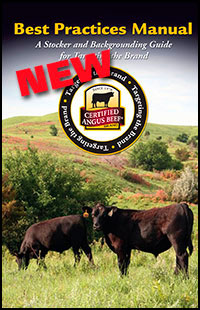
Click here to view Certified Angus Beef LLC (CAB) Best Practices Manual for stockers.
Guide to the Best
New manual guides stocker-backgrounders to quality.
When it comes to beef quality, the stocker industry is sometimes considered oblivious, or driven only by pounds. But market dynamics have continued to build the case that quality matters to these entrepreneurs, and, of course, they matter in any discussion of beef quality.
That's why Certified Angus Beef LLC (CAB) recently published its Best Practices Manual (BPM) for stocker operators and backgrounders, a guide to targeting the Certified Angus Beef® brand.
"The stocker segment has historically been considered a low-cost, margin operator," says Mark McCully, CAB assistant vice president for supply. "The reality is they have a huge influence on end-product merit, and those best management practices need to be identified and kept in mind." Read more.
New Products
Industry affiliates provide a wide array of products and services to assist you on the farm and ranch. Here's an assortment of new products to hit the market in the last few months.
• Nutritional product for feedlot cattle
• Changing dual tractor tires now a one-person job
• Baler can produce high-density bales using smaller hp tractors
• New Hobart portable welding system
• Enclosed-case Lincoln engine driven welder/generator
• Lincoln engine-driven welders




